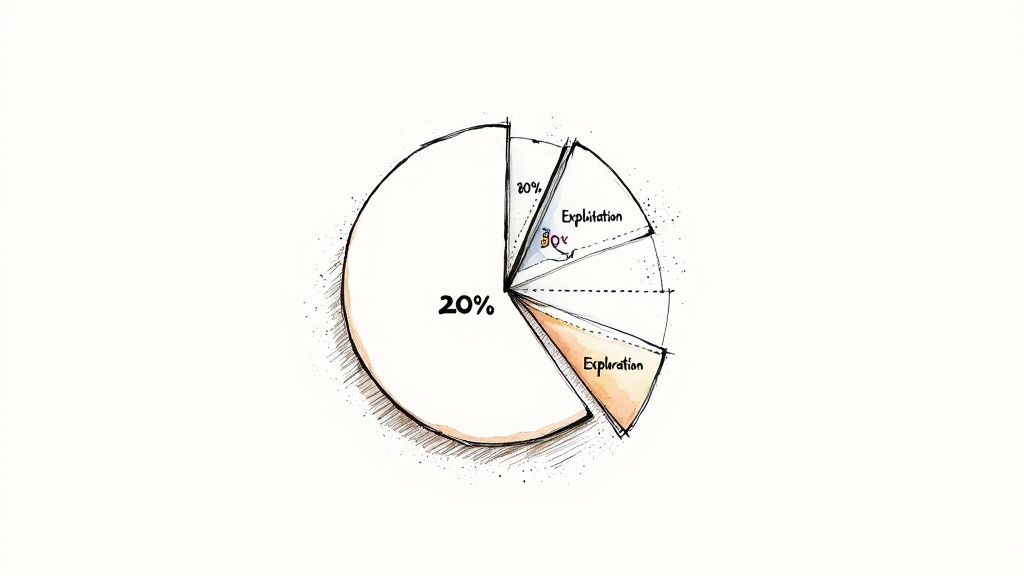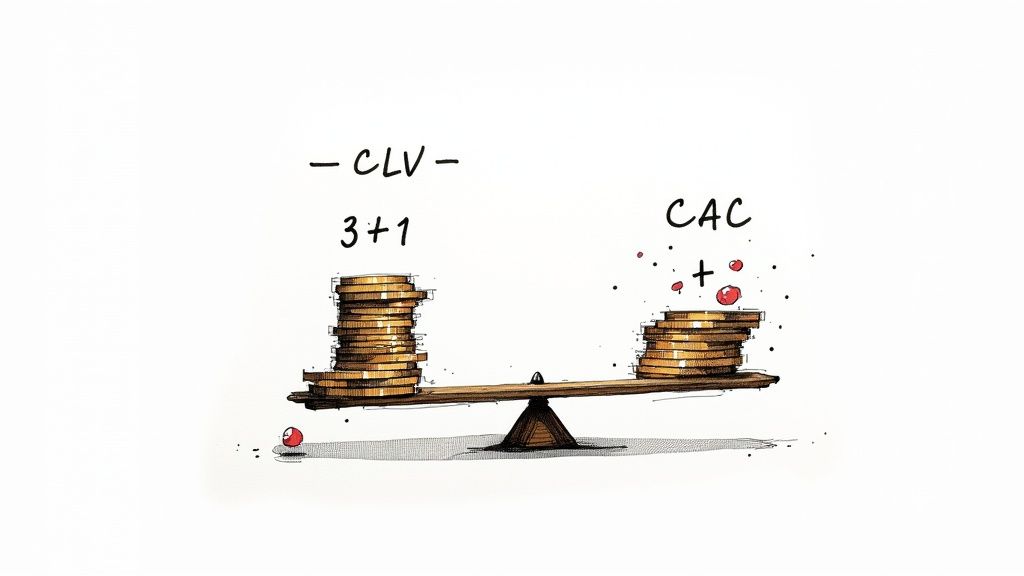
Mastering Your Lead Generation Strategy: Proven Tactics for 2025
Master lead generation strategy for 2025 with proven tactics. Learn content marketing, SEO, ABM, AI, and more for sustainable business growth.

Allocating your marketing budget can feel more like a guessing game than a science. Do you pour more into social media, double down on SEO, or experiment with a new channel that just caught your eye? The wrong move can waste precious resources and stall your progress, while the right one can unlock explosive growth. The difference often comes down to a strategic, well-defined approach to spending.
This guide moves beyond arbitrary percentages. We're here to provide a clear roadmap with 10 proven marketing budget allocation best practices that successful companies use to turn their marketing spend into a powerful growth engine. These methods allow businesses to invest every dollar with precision and purpose, ensuring they maximize their return on investment.
A foundational understanding of Modern Marketing Budget Planning is essential for setting the stage for more advanced allocation strategies. This article builds on those core concepts, offering actionable frameworks you can implement immediately.
Whether you're an entrepreneur or a seasoned marketing professional, you will learn how to:
Forget the guesswork. Let’s dive into the strategies that will help you stop simply spending money and start strategically investing in sustainable growth.
One of the most effective marketing budget allocation best practices is to let past performance guide future spending. Instead of relying on guesswork, this method uses historical data—such as return on investment (ROI), customer acquisition cost (CAC), and conversion rates—to make informed decisions. By analyzing what has worked before, you can confidently allocate more funds to the channels and campaigns that deliver the best results.
This approach moves your strategy from reactive to proactive. It enables you to identify your most profitable marketing activities and double down on them, ensuring every dollar is invested where it has the highest potential for return. For a deeper dive into this concept, you can explore the fundamentals of data-driven marketing on brandbooster.ai.

A powerful marketing budget allocation best practice is the 80/20 rule, which balances predictable returns with necessary innovation. This model dedicates 80% of your budget to proven, high-performing channels and strategies (exploitation) while allocating the remaining 20% to experimenting with new ideas, platforms, and technologies (exploration). This approach ensures stable, ongoing results while creating opportunities for future growth.
This strategic split prevents marketing efforts from becoming stagnant. By consistently investing in proven tactics, you secure your baseline ROI. Simultaneously, the experimental 20% acts as a research and development fund, allowing you to discover the next high-performing channel before your competitors do. This balance is key to long-term market leadership and adaptability.

A powerful method for marketing budget allocation involves aligning spending with the Objective and Key Results (OKR) framework. Instead of assigning funds to channels based on tradition, this approach ties every dollar to specific, measurable business goals. The budget is allocated to initiatives that directly support strategic objectives, such as boosting brand awareness, generating qualified leads, or improving customer retention.
This framework ensures that marketing spending is not just an expense but a direct investment in achieving core business priorities. It creates a clear line of sight between marketing activities and their impact on the company's bottom line. By focusing on outcomes rather than outputs, the OKR method encourages teams to think strategically about how to achieve their goals, fostering a culture of accountability and results-driven performance.
One of the most strategic marketing budget allocation best practices involves focusing on the long-term profitability of your customers. Instead of just chasing low-cost acquisitions, this method prioritizes the balance between Customer Lifetime Value (CLV) and Customer Acquisition Cost (CAC). It directs your budget toward channels that attract customers who are not only affordable to acquire but also generate significant value over their entire relationship with your brand.
This approach shifts your marketing focus from short-term transactions to sustainable, long-term growth. By understanding which channels deliver high-CLV customers at an acceptable CAC, you can invest confidently, knowing your marketing dollars are fostering profitable relationships. To learn more, see this guide on calculating and using CLV on hubspot.com.

The zero-based budgeting (ZBB) approach flips traditional budgeting on its head. Instead of adjusting the previous year's budget, ZBB requires marketers to justify every single expense from scratch for each new budget cycle. This method forces a critical evaluation of all spending, ensuring that funds are allocated only to initiatives that promise a clear, justifiable return on investment.
By starting from zero, this marketing budget allocation best practice eliminates legacy spending and forces teams to question the value of every program. It promotes a culture of accountability and efficiency, pushing marketers to think like business owners and prove the necessity of their proposed activities. Companies using ZBB can uncover and eliminate outdated or inefficient spending, reallocating those funds to more impactful, modern strategies.
Relying on simplistic metrics can lead to misallocating your marketing budget. Attribution modeling offers a more sophisticated solution by helping you understand how different channels contribute to conversions throughout the entire customer journey. Instead of only crediting the final touchpoint, this practice analyzes the full path, allowing you to allocate funds based on each channel's true influence.
This approach prevents you from overvaluing channels that close deals and undervaluing those that create initial awareness. By understanding the complete picture, you can make smarter investment decisions, optimize your marketing mix, and achieve a more accurate assessment of your return on investment. It’s a core component of effective marketing budget allocation best practices and ties closely to how you measure marketing ROI on brandbooster.ai.
Static annual budgets are becoming a relic of the past in today's fast-paced market. Adopting an agile approach through scenario planning allows you to stay responsive and capitalize on opportunities as they arise. This practice involves creating multiple budget models for best-case, base-case, and worst-case scenarios, giving you a ready-to-deploy plan no matter what the market throws at you.
This dynamic strategy ensures your marketing budget allocation is not a rigid, year-long commitment but a flexible tool that adapts to real-time performance data and market shifts. Instead of being caught off guard by unexpected events or competitive moves, you can pivot quickly, reallocating funds to channels that are suddenly outperforming or pulling back from those that are lagging. This agility is a significant competitive advantage.
A highly strategic approach is to distribute funds across the customer journey rather than just by channel. This method ensures you are engaging potential customers at every stage: Awareness, Consideration, Conversion, and Retention. By assigning specific budget percentages to each phase of the funnel, you can build a comprehensive marketing engine that not only attracts new leads but also nurtures them into loyal, repeat customers.
This practice forces a holistic view of your marketing, preventing over-investment in one area (like lead generation) at the expense of another (like customer retention). It ensures a balanced strategy where each stage receives the resources needed to move customers smoothly to the next, identifying and addressing potential bottlenecks before they impact revenue. Learn more about mastering your lead generation funnel for sustained growth.
One established practice involves looking externally at your competitors. The competitive parity method sets your budget in line with what rivals are spending, while a share of voice (SOV) strategy aims to capture a specific percentage of the total advertising presence within your industry. This approach helps ensure you aren't drowned out in a crowded market.
This strategy is about maintaining visibility and relevance. By monitoring and reacting to competitor spending, you can protect your market share and prevent rivals from dominating the conversation. It’s particularly effective in mature, highly competitive industries where brand recall and top-of-mind awareness are critical for attracting and retaining customers.
Adopting a test-and-learn methodology involves dedicating a protected portion of your budget specifically for controlled experiments and A/B testing. This practice allows you to validate assumptions and discover new opportunities before committing significant resources. By "ring-fencing" funds for innovation, you create a safe space to test new channels, messaging, or tactics without risking your core marketing budget.
This systematic approach to innovation is a cornerstone of effective marketing budget allocation. It empowers you to make decisions based on statistical evidence rather than intuition, ensuring that when you do scale a new initiative, it’s built on a foundation of proven success. This method mitigates risk while continuously fueling your strategy with fresh, data-validated insights.
Navigating marketing budget allocation isn't about finding a single magic formula. It's about building a resilient, intelligent, and adaptable financial strategy. The most effective approach is a dynamic hybrid, combining the best of what we've discussed. By mastering these marketing budget allocation best practices, you move beyond guesswork and into strategic, data-informed decision-making. You stop asking "How much should we spend?" and start asking "Where can our next dollar make the biggest impact?"
The power of these ten strategies is amplified when they work in concert. Imagine combining the precision of Zero-Based Budgeting with the forward-thinking nature of the 80/20 split. You start each quarter with a clean slate, forcing justification for every dollar, but you also build in a 20% "exploration" fund to test new channels. This creates a system that is both highly accountable and inherently innovative.
Similarly, overlaying Funnel-Based Allocation with sophisticated Attribution Modeling provides a complete picture. You can allocate funds across the funnel, and your attribution model will tell you precisely which touchpoints are most effective.
Key Insight: The goal isn't to pick one perfect budgeting method. It's to create a customized framework that blends historical data analysis with agile, forward-looking experimentation. This turns your budget into a strategic tool for sustainable growth.
Progress starts with a single step. You don't need to implement all ten practices overnight. Here is a practical roadmap:
Mastering these marketing budget allocation best practices is about creating a culture of financial intelligence and accountability. It’s about building a system that learns, adapts, and consistently finds the most efficient path to growth. When your budget is aligned with clear objectives, supported by data, and flexible enough to seize new opportunities, it becomes your single greatest competitive advantage.
Ready to transform your marketing budget from a line item into a revenue-generating machine? BrandBooster.ai leverages advanced AI to analyze your performance data and pinpoint the most effective allocation strategies for maximum impact. Take the guesswork out of budgeting and ensure every dollar you spend delivers a measurable return by visiting BrandBooster.ai today.